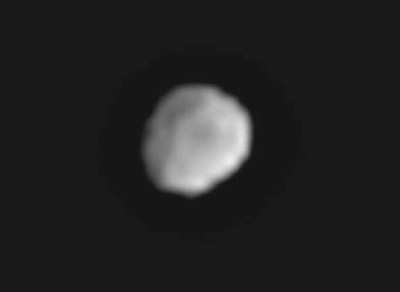Thu, Jun 16, 2011
Orbit Insertion Is Expected July 16
Scientists working with NASA's Dawn spacecraft have created a
new video showing the giant asteroid Vesta as the spacecraft
approaches this unexplored world in the main asteroid belt. The
video loops 20 images obtained for navigation purposes on June 1.
The images show a dark feature near Vesta's equator moving from
left to right across the field of view as Vesta rotates. Images
also show Vesta's jagged, irregular shape, hinting at the enormous
crater known to exist at Vesta's south pole.

Capture From NASA Video
The images were obtained by a framing
camera during a 30-minute period and show about 30 degrees of a
rotation. The pixel size in these images is approaching the
resolution of the best Hubble Space Telescope images of Vesta.
"Like strangers in a strange land, we're looking for familiar
landmarks," said Jian-Yang Li, a Dawn participating scientist from
the University of Maryland, College Park. "The shadowy spot is one
of those -- it appears to match a feature, known as 'Feature B,'
from images of Vesta taken by NASA's Hubble Space Telescope."
Before orbiting Vesta on July 16, Dawn will gently slow down to
about 75 mph. NASA is expecting to release more images on a weekly
basis, with more frequent images available once the spacecraft
begins collecting science at Vesta.
"Vesta is coming more and more into focus," said Andreas Nathues,
framing camera lead investigator, based at the Max Planck Institute
for Solar System Research, Katlenburg-Lindau, Germany. "Dawn's
framing camera is working exactly as anticipated."

NASA Image
The Dawn mission is managed by NASA's
Jet Propulsion Laboratory in Pasadena, Calif., for the agency's
Science Mission Directorate in Washington. Dawn is a project of the
directorate's Discovery Program, managed by NASA's Marshall Space
Flight Center in Huntsville, Ala. UCLA is responsible for overall
Dawn mission science. Orbital Sciences Corp. of Dulles, Va.,
designed and built the Dawn spacecraft. The framing cameras were
developed and built under the leadership of the Max Planck
Institute for Solar System Research in Katlenburg-Lindau, Germay.
The German Aerospace Center (DLR) Institute of Planetary Research
in Berlin made significant contributions in coordination with the
Institute of Computer and Communication Network Engineering in
Braunschweig. The framing camera project is funded by the Max
Planck Society, DLR and NASA. JPL is a division of the California
Institute of Technology in Pasadena.
More News
Aero Linx: Model Aeronautical Association of Australia MAAA clubs are about fun flying, camaraderie and community. For over 75 years, the MAAA has been Australia’s largest fl>[...]
Touchdown Zone Lighting Two rows of transverse light bars located symmetrically about the runway centerline normally at 100 foot intervals. The basic system extends 3,000 feet alon>[...]
“Discovery and innovation are central to our mission at Virgin Galactic. We’re excited to build on our successful record of facilitating scientific experiments in subor>[...]
How To Get A Story On Aero-TV News/Feature Programming How do I submit a story idea or lead to Aero-TV? If you would like to submit a story idea or lead, please contact Jim Campbel>[...]
Student Pilot Reported That During Rotation, “All Of A Sudden The Back Of The Plane Kicked To The Right..." Analysis: The student pilot reported that during rotation, “>[...]
 ANN's Daily Aero-Linx (05.02.24)
ANN's Daily Aero-Linx (05.02.24) ANN's Daily Aero-Term (05.02.24): Touchdown Zone Lighting
ANN's Daily Aero-Term (05.02.24): Touchdown Zone Lighting Aero-News: Quote of the Day (05.02.24)
Aero-News: Quote of the Day (05.02.24) ANN FAQ: Contributing To Aero-TV
ANN FAQ: Contributing To Aero-TV NTSB Final Report: Cirrus Design Corp SR20
NTSB Final Report: Cirrus Design Corp SR20




